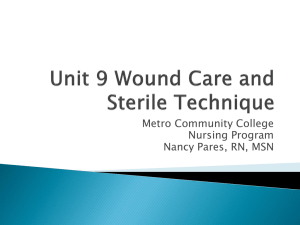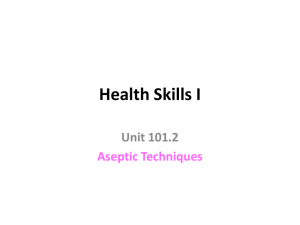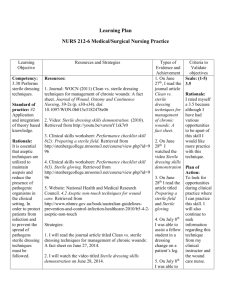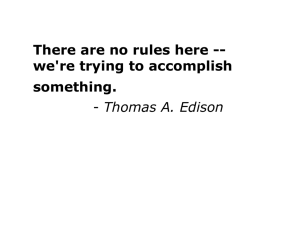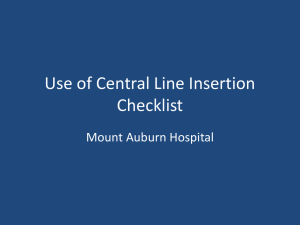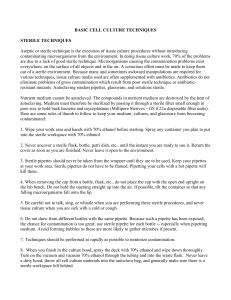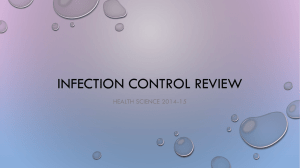Hydrotherapy
advertisement
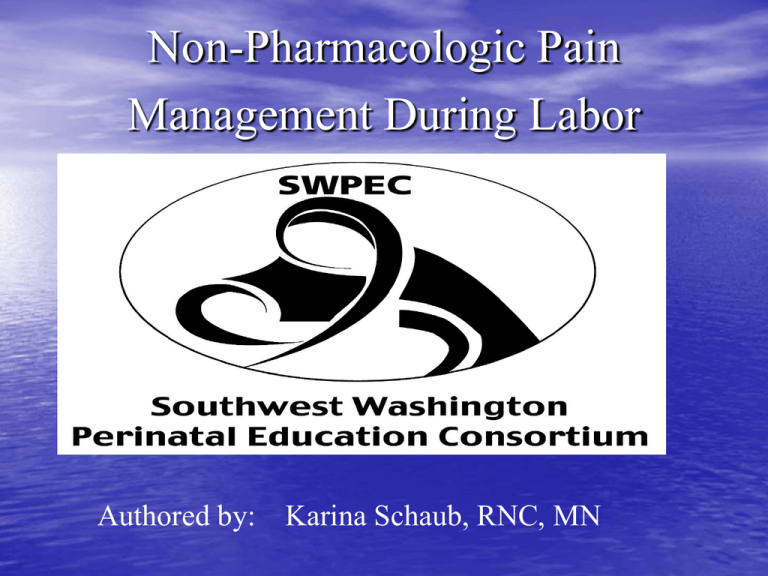
Non-Pharmacologic Pain Management During Labor Authored by: Karina Schaub, RNC, MN Objectives • Identify several non-pharmacologic ways to help patients cope with labor pain • Know the contraindications for certain methods of pain relief • Identify several ways nurses can show support for the pt and their support people Physiologic Responses to Pain • • • • • Release of Catecholamines BP HR RR Tension Information to Discuss Upon Admission • Review Birth Plan • Discuss pain relief options and coping mechanisms • Advise support person • Discuss FHM standards Empowering Women to Give Birth • • • • • Motivation Encouragement Position changes Offer advice to support person Physical Presence Fetal Monitoring Standards per ACOG • Low risk patients: – 20 minute strip initially – Active Labor: during and 30 seconds after a contraction Q 30 min – 2nd Stage: during and 30 seconds after a contraction Q 15 min ** Always follow your hospital’s protocol Fetal Monitoring Standards per ACOG • High risk patients: – 20 minute strip initially – Active Labor: during and 30 seconds after a contraction Q 15 min – 2nd Stage: during and 30 seconds after a contraction Q 15 min ** Always follow your hospital’s protocol National Organization Support Association of Women’s Health, Obstetric, and Neonatal Nurses (AWHONN) American College of Obstetricians and Gynecologists (ACOG) Research Study Support “The presence of a doula during labor… Lower use of analgesia, Lower C/S rate, Increased maternal satisfaction.” (Berghella, et al, 2008) Personal Needs • Nutrition – Water – Ice chips – 120 cal/hr • Elimination Non-Pharmacologic Coping Mechanisms Walking Swaying Rocking Chair Birthing Ball Changing Positions Squatting Bar Tub Rebozo Distractors Focal Point Visualization Music Aromatherapy Heat/Cold Massage Acupressure Hypnobirthing Movement • Walking • Swaying • Hands & Knees Using Props • Rocking Chair • Birthing Ball Using Props • Squatting Bar – Put bed into chair position – Squat holding the bar – Pull on sheet Using Props • Rebozo – Support with rebozo under arms to relax neck, shoulders, and back – Passive Movement Relaxation Hydrotherapy “Liquid Epidural” – Less pain – Less muscle tension – Reduces effect of gravity on mother Hydrotherapy Contraindications: Maternal fever> 100.4 or suspected maternal infections Amnionitis Documented non-reassuring FHR Condition requiring continuous EFM Excessive vaginal bleeding Epidural Anesthesia Malpresentation Other conditions at discretion of HCP Hydrotherapy • Water temp mildly warm • Push fluids • Offer towel to drape over pt for privacy Hydrotherapy • Decreases pain sensation • Less use of IM/IV/epidural analgesia • Fewer instrumental deliveries • Decreased incidence of cesarean sections • Decreased incidence of perineal trauma • Increased maternal satisfaction (Berghella, et al, 2008) Does bath water enter vagina? • Research Study: Tampon placed in vagina before entering the water Potassium iodide solution placed in tub water No tampons reacted to the iodide until they were removed Conclusion: Bath water does NOT enter the vagina (Siegel, 1990) Hydrotherapy after SROM – No differences in maternal or neonatal infections, asphyxia or resp problems. • Waldenstrom. et al, 1992 - Pre-labor SROM – No differences in maternal or neonatal infection rate. • Erolsspm. et al, 1996 Perineal Massage • • • • Starting at 34 wks Almond oil 5-10 min daily Perineal Massage 2nd stage Warm pack 2nd stage (Berghella, et al, 2008) Sterile Water Papules • • • • • Injection of Sterile Water in 4 areas Burns x 30-90 seconds Back pain relieved in 2-3 minutes Pain relief x 2-3 hours May be repeated ** Note – does not relieve contraction pain Sterile Water Papules • • • • MD, CNM, RN Best to have 2 people inject at the same time Tuberculin syringes, 0.3 ml of Sterile Water Locate injection site over sacrum (4 injections) Sterile Water Papules • Cleanse area with alcohol • Inject 0.15 ml of the Sterile Water intradermally in each site • Watch for a wheal to form Using the Senses • Focal Point (sight) – Spot on the wall – Calming photo • Music (sound) – CD’s, IPOD, Headphones – Activates the right brain Using the Senses • Aromatherapy (smell) – Clary Sage: Anxiety, Fatigue, Stress – Jasmine: Confidence, Fatigue, Stress – Lavender: Anxiety, Irritability, Stress – Peppermint: Fatigue, Relaxes urinary meatus – Rose: Anxiety, Stress Using the Senses • Heat/Cold (touch) – Cool cloth – Fan – Warm tub • Massage (touch) – Back – Feet – Tennis Ball Mind over Matter • Distractors – TV – Children playing – Cleaning • Visualization – Visualize a favorite place where you can think of smells, sounds, feelings… Breathing Rhythm in Labor • Breathing patterns – Slow deep breaths 1st Stage – Feeling pushy but can’t push yet? • Pant – short quick breaths out Acupressure • For Nausea/Vomiting – Inner Gate or Neiguan P6 Pressure Point Acupressure • Pain relief during labor – Hegu li-4 pressure point Hand Reflexology • Pressure on the balls of the hand and finger tips • Can use in both hands Acupressure • Cervical Dilation – Sanyinjiao SP-6 Hypnobirthing • Childbirth method using mind/body and • • • meditation science Deep relaxation Eliminate Fear, Tension, and Pain Techniques improve immune and nervous system function in preparation for birth: – Teaches to recognize and release fears in labor – Teaches to extend natural labor pain management Conclusion • Combine different techniques based on your assessment of pt’s needs • Provide rationale behind the various methods of pain relief • Let the pt and family know that you are there for them Questions ? References Berghella, V., Baxter, J., & Chauhan, S. (2008). Evidence-based labor and delivery management. American Journal of Obstetrics and Gynecology. 445-454. Retrieved February 1, 2011 from www.AJOG.org. Birthing Ball. [Online Image] Retrieved June 23, 2009 from http://www.birthease.co.uk/birthease_shop/Shop-Products/Birth-BirthingBall/Birth-Birthing-Ball-Large-Image.jpg. Buckle, J. (2000). Aromatherapy for Health Professionals. Cervical Dilation Acupressure. [Online Image] Retrieved June 22, 2009 from http://acupuncture.rhizome.net.nz/acupressure/images/sp6_2.gif. Childbirth Instructor Magazine. (1997). The Moaning Option. 2nd Quarter Dougans, I. (2003). Reflexology: The Complete Illustrated Guide to Therapeutic Foot Massage for Health and Well-being. Intradermal Injection. [Online Image] Retrieved June 23, 2009 from http://www.hivandhepatitis.com/0_images_2008/tb_hosp2.gif Jonquil, S. (1997). Midwifery Today. Sterile Water Blocks for Back Pain in Labor. Kunz, K. & Kunz, B. (2003). Reflexology: Health at your fingertips. 120-121. Labor Bathtub. [Online Image] Retrieved June 23, 2009 from http://www.discoversanmiguel.com/images2010/Twin-Cities-LaborTub.jpg References Cont’d Labor Squatting Bar. [Online Image] Retrieved June 23, 2009 from http://www.google.com/imgres?imgurl=http://www.wpahs.org/womenshealth/clinical/services/images/OBtour_25_001.jpg&i mgrefurl=http://crispy-not-crunchy.blogspot.com/2009/08/littlests-birthstory.html&usg=__8786P5Mwt3BMFqt3IBMMGJwmpiU=&h=188&w=240&sz=38&hl=en&start=7&itbs=1&tbnid=UM0y N02DhWKrGM:&tbnh=86&tbnw=110&prev=/images%3Fq%3Dlabor%2Bsquatting%2Bbar%26hl%3Den%26sa%3DN%26 gbv%3D2%26ndsp%3D20%26tbs%3Disch:1 Mongan, Marie. (2006). Hypnobirthing: The Mongan Method. Pfeil, Aerlyn, CPM. (2007). Sterile Water Papules for Back Labor Relief. Sterile Water Papule Injection Sites. [Online Image] Retrieved May 3, 2009 from http://www.scielo.br/img/revistas/rba/v56n5/en_12f1.gif. Tisserand, R. (1977). Healing Arts Press. Art of Aromatherapy. Trolle, B., Moller, M., Kronberg, H. & Thomsen, S. (1991). American Journal of Obstetrics and Gynecology. The Effects of Sterile Water Blocks on Low Back labor Pain.
